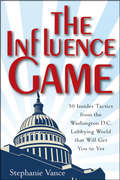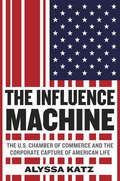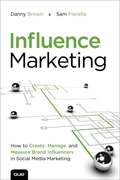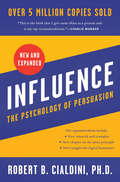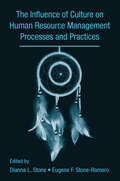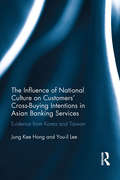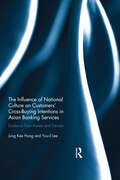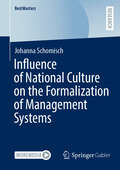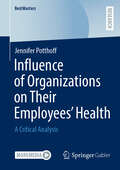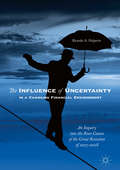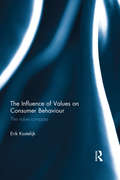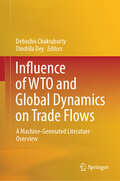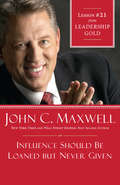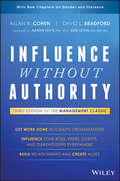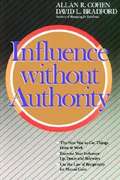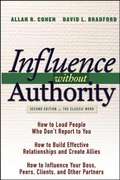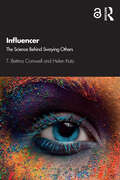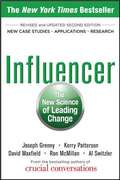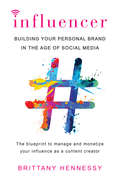- Table View
- List View
The Influence Game
by Stephanie VanceGet what you want, every time!Imagine a world where you are offered every job you seek; every business venture you undertake is successful; and every potential customer you approach buys your product. Now imagine that all of this can be achieved--ethically and honestly. All you need is the help of one battle-tested guide, The Influence Game. Former Washington, D.C. lobbyist Stephanie Vance dispenses everything she's learned about effective (and, believe it or not, honest) persuasion. Learn how to apply this power to any situation by using D.C. insider influence strategies and applying a step-by-step, easy-to-understand process for success. Learn how to develop and articulate effective goalsStructure both long and short-term persuasion effortsIdentify and research primary and secondary audiencesCrafting those all important personal storiesStephanie Vance has seen the influence game from every angle. Follow her lead to get past being heard to the real goal of being agreed with.
Influence Is Your Superpower: The Science of Winning Hearts, Sparking Change, and Making Good Things Happen
by Zoe ChanceRediscover the superpower that makes good things happen, from the professor behind Yale School of Management's most popular class &“The new rules of persuasion for a better world.&”—Charles Duhigg, author of the bestsellers The Power of Habit and Smarter Faster Better You were born influential. But then you were taught to suppress that power, to follow the rules, to wait your turn, to not make waves. Award-winning Yale professor Zoe Chance will show you how to rediscover the superpower that brings great ideas to life.Influence doesn&’t work the way you think because you don&’t think the way you think. Move past common misconceptions—such as the idea that asking for more will make people dislike you—and understand why your go-to negotiation strategies are probably making you less influential. Discover the one thing that influences behavior more than anything else. Learn to cultivate charisma, negotiate comfortably and creatively, and spot manipulators before it&’s too late. Along the way, you&’ll meet alligators, skydivers, a mind reader in a gorilla costume, Jennifer Lawrence, Genghis Khan, and the man who saved the world by saying no. Influence Is Your Superpower will teach you how to transform your life, your organization, and perhaps even the course of history. It&’s an ethical approach to influence that will make life better for everyone, starting with you.
The Influence Machine: The U.S. Chamber of Commerce and the Corporate Capture of American Life
by Alyssa KatzAn illuminating history and groundbreaking investigation tracing how a single trade organization turned itself into the most dangerous political weapon in America When Americans hear the words "Chamber of Commerce," many still think of the local business associations that spruce up Main Streets and sponsor Little League teams around the country. But the United States Chamber of Commerce is a different animal altogether. The Chamber was originally founded to give big business a voice during the long--and now almost inconceivable--period in American history that saw the rise of workers' rights, consumer protections, and environmental awareness as national priorities. But over time, driven by an antigovernment ideology and its desire for financial and political power, the Chamber metastasized into a fighting force designed to protect the worst excesses of American industry. The Chamber, through its veiled corporate sponsors, can take credit for some of the most disturbing trends in American life: the reversal of environmental protections, the destruction of unions and worker protections, the rise of virulent antigovernment ideology, the enlarged role of money in campaigns, and the creation of "astroturf" movements as cover for a corporate agenda. Through its propaganda, lobbying, and campaign cash, the Chamber has created a right-wing monster that even it struggles to control, a conservative movement that is destabilizing American democracy as never before. The Influence Machine tells this history as a series of gripping narratives that take us into the backrooms of Washington, where the battles over how our country is run and regulated are fought, and then out into the world, where we see how the Chamber's campaigns play out in real lives. In the end, Alyssa Katz reveals the hidden weaknesses of this seeming juggernaut and shows how its antidemocratic agenda can be reversed. Praise for Alyssa Katz's Our Lot: How Real Estate Came to Own Us "[A] trenchant chronicle of how 'all that had been sacred about home lending' was upended, through a series of government policies that were enacted with seemingly noble intentions--broadening home ownership and priming the economic pump--but ended up turning homes into profit centers rather than places to live."--Tom Vanderbilt, The New York Times Book Review "Her reporting was prescient. . . . Katz [is] a talented, insightful [reporter], and [her book] advances our understanding of the mortgage meltdown."--Kristin Downey, The Washington Post "[A] richly detailed analysis of the recent (and ignominious) history of the American real estate market . . . Katz writes with authority and empathy. The many people the author interviews, from the single mother in Cleveland who lost her house just two years after buying it to the family living near Sacramento whose new home is already falling apart, become the heroes, victims and sometimes culprits in this gripping account of collective irresponsibility."--Publishers Weekly (starred review)From the Hardcover edition.
Influence Marketing: How to Create, Manage, and Measure Brand Influencers in Social Media Marketing (Que Biz-Tech)
by Danny Brown Sam Fiorella<p>Today, you face a brutally tough, maddeningly elusive new competitor: the “wisdom of crowds.” Social media gives consumers 24x7 access to the attitudes and recommendations of their most engaged peers. These are the views that shape buying decisions. These are the views you must shape and use. Influence Marketing won’t just help you identify and enlist key influencers: it will help you manage the influence paths that lead consumers to buy. <p>By sharing empirical evidence of hard-won lessons from pioneering influence marketers, Danny Brown and Sam Fiorella provide a blueprint that moves influence marketing beyond simple brand awareness and into sales acquisition and customer life time value measurement. They integrate new tools and techniques into a complete methodology for generating more and better leads—and converting them faster, at higher margins.</p>
Influence, New and Expanded: The Psychology of Persuasion
by Robert B Cialdini PhDThe foundational and wildly popular go-to resource for influence and persuasion—a renowned international bestseller, with over 5 million copies sold—now revised adding: new research, new insights, new examples, and online applications.In the new edition of this highly acclaimed bestseller, Robert Cialdini—New York Times bestselling author of Pre-Suasion and the seminal expert in the fields of influence and persuasion—explains the psychology of why people say yes and how to apply these insights ethically in business and everyday settings. Using memorable stories and relatable examples, Cialdini makes this crucially important subject surprisingly easy. With Cialdini as a guide, you don’t have to be a scientist to learn how to use this science.You’ll learn Cialdini’s Universal Principles of Influence, including new research and new uses so you can become an even more skilled persuader—and just as importantly, you’ll learn how to defend yourself against unethical influence attempts. You may think you know these principles, but without understanding their intricacies, you may be ceding their power to someone else.Cialdini’s Principles of Persuasion:ReciprocationCommitment and ConsistencySocial Proof Liking AuthorityScarcityUnity, the newest principle for this editionUnderstanding and applying the principles ethically is cost-free and deceptively easy. Backed by Dr. Cialdini’s 35 years of evidence-based, peer-reviewed scientific research—including a three-year field study on what leads people to change—Influence is a comprehensive guide to using these principles to move others in your direction.
The Influence of Culture on Human Resource Management Processes and Practices (Applied Psychology Ser.)
by Dianna L. Stone Eugene F. Stone-RomeroIt is clear that organizations are becoming more culturally diverse, and a better understanding of multiculturism and its impact on organizations is needed. This book, with contributions from expert academics, is designed to motivate both the further development of models concerned with the influence of cultural diversity on several Human Resource
The Influence of Culture on Human Resource Management Processes and Practices (Applied Psychology Series)
by Dianna L. Stone Eugene F. Stone-RomeroThis book, with contributions from expert academics, is designed to motivate both the further development of models concerned with the influence of cultural diversity on several human resource management processes and practices and the design and conduct of empirical research on the same topic.
The Influence of Islamic Values on Management Practice
by Gillian ForsterThe Influence of Islamic Values on Management Practice is a cultural study examining how Islamic values influence management practice. Using Morocco as a case study, and with academic research and actual business managers working in this context, the book explores and explains how national characteristics, including Islam, shape management practice
The Influence of National Culture on Customers' Cross-Buying Intentions in Asian Banking Services: Evidence from Korea and Taiwan
by Jung Kee Hong You-il LeeThe traditional walls between banking, insurance and securities markets are breaking down as a result of deregulation and liberalization of financial services. The cross-buying of financial services has become a global trend as a part of the convergence of financial services. This trend has recently commenced in East Asian countries, such as Taiwan and Korea, where the tremendous growth of these activities has been noticed. The book explores what the determinants of this growth in East Asia, particularly in Korea and Taiwan are, and how these determinants influence differently to the customers of these two countries when compared with the studies conducted on other countries (e.g. Europe and North America). The book opens the view on the subject of customers’ behavioral intentions of cross-buying banking services in East Asian countries, especially from a cross-cultural perspective and empirically tested findings help marketing personnel in financial institutions, marketing practitioners’ in banks and researchers of financial services and marketing, understanding on East Asia such as Taiwan and Korea, where the tremendous growth of these activities has been noticed in recent years.
The Influence of National Culture on Customers' Cross-Buying Intentions in Asian Banking Services: Evidence from Korea and Taiwan
by Jung Kee Hong You-il LeeThe traditional walls between banking, insurance and securities markets are breaking down as a result of deregulation and liberalization of financial services. The cross-buying of financial services has become a global trend as a part of the convergence of financial services. This trend has recently commenced in East Asian countries, such as Taiwan and Korea, where the tremendous growth of these activities has been noticed. The book explores what the determinants of this growth in East Asia, particularly in Korea and Taiwan are, and how these determinants influence differently to the customers of these two countries when compared with the studies conducted on other countries (e.g. Europe and North America). The book opens the view on the subject of customers’ behavioral intentions of cross-buying banking services in East Asian countries, especially from a cross-cultural perspective and empirically tested findings help marketing personnel in financial institutions, marketing practitioners’ in banks and researchers of financial services and marketing, understanding on East Asia such as Taiwan and Korea, where the tremendous growth of these activities has been noticed in recent years.
Influence of National Culture on the Formalization of Management Systems (BestMasters)
by Johanna SchomischIn this book, it was researched whether differences in the formalization of management systems occur in certain countries and whether these can be attributed primarily to the culture of the country or whether there are other influences. A quantitative study was conducted in which the five factors Need for Instructions, Compliance with Instructions, Supervisor Support, Change Management, and Overformalization were surveyed and analysed with the cultural dimensions Power Distance and Uncertainty Avoidance according to Hofstede and GLOBE. The analysis has shown that the national culture has an influence on the formalization of management system measured by three of the five factors. Moreover, a correlation of the factor Overformalization with Hofstede’s UAI and a preference for centralization in high PD countries were identified. Although the differences in the formalization of the management system are not limited to cultural aspects, they are the only ones with high significance.
Influence of Organizations on Their Employees’ Health: A Critical Analysis (BestMasters)
by Jennifer PotthoffThe modern working world, characterized by a VUCA-world, digitalization, and demographic change, is transforming the way of working, offering benefits like increased flexibility but also bringing uncertainty, constant change, and new tasks. These developments pose new challenges to leaders and employees, reflected in rising sick days in Germany. Given the financial damage of presenteeism and absenteeism for individual companies and the German economy, organizations must find ways to maintain their employees’ mental and physical health. Despite the growing importance of health in the corporate context, in Germany the potential of workplace health promotion is not yet fully exploited. This book highlights how modern behavioral economic incentive systems, using psychological insights on people’s real decision-making behavior, can enhance corporate health promotion. Jennifer Potthoff designed the MIND-THE-GAP-toolbox for organizations to motivate their employees to eat healthier, improve physical activity, and reduce stress at work. Additionally, the book discusses how leaders can support employee health through a health-oriented leadership style characterized by self-care, mindfulness, staff-care, appreciation, empathy, trust, communication, fairness, and a balance between scope for action and task orientation.
The Influence of Uncertainty in a Changing Financial Environment
by Ricardo A. HalperinThis book examines the role of uncertainty on financial decisions - and, consequently, on financial markets - in the buildup to and aftermath of the Great Recession. It tracks the significant growth and important structural changes in the financial sector during the past few decades, both of which made the economy more vulnerable to perceptions of risk in the markets. Halperin argues that conventional economic models have lost relevance by failing to take these developments into account appropriately, and also explains that because of financial globalization we can no longer understand what happens in the economies of major countries by relying on "closed-economy" thinking. The book concludes with a list of policy recommendations designed to increase the resilience of the financial markets to negative economic developments and to reduce incentives for risk taking, including a proposal to eliminate the double taxation of dividends.
The Influence of Values on Consumer Behaviour: The value compass
by Erik KostelijkSubstantial progress has been made in the conceptualization of values within psychology. The importance of values is also acknowledged in marketing, and companies use values to describe the core associations of their brand. Yet despite this, the values concept has received limited attention in marketing theory. The Influence of Values on Consumer Behaviour aims to bridge the gap between the conceptual progress of values in psychology, and the current practice in marketing and branding literature. It proposes the ‘Value Compass’, a comprehensive value system that is cross-culturally applicable to consumer behaviour and brand choice. The values concept is used in psychology to identify the motivations underlying behaviour, a concept that marketers have borrowed to define brand values. This has led to conceptual confusion. Whereas in psychology the values system is perceived as an integrated structure, in marketing, values are treated as abstract motivations that give importance to the benefits of consumption. Attention in marketing has shifted away from brand values toward brand personality, a set of human characteristics associated with a brand. Despite its popularity, brand personality has limitations in explaining consumer behaviour, while the potential merits of a brand values concept have remained largely unexplored. The book presents a meaningful alternative to the brand personality concept and promotes the benefits of using the Value Compass for assessing the effects of brand values and personal values on consumer choice. As such, it will be essential reading for academics and postgraduate students in the fields of marketing, consumer psychology, branding, consumer choice behaviour and business studies.
Influence of WTO and Global Dynamics on Trade Flows: A Machine-Generated Literature Overview
by Debashis Chakraborty Oindrila DeyThis book is a machine-generated literature overview that explores the impact of the World Trade Organization (WTO) on international trade and its development. It looks at international trade before and after 1995 when WTO was established. It highlights the journey of the reciprocity-based reforms under WTO that were expected to help the developing and less developed countries (LDCs) more vis-à-vis their developed counterparts, given the existence of systemic and structural bottlenecks in the latter territories. The enabling steps were further expected to promote exports from developing countries and LDCs in line with their comparative advantage patterns, enhance the wage level and in turn, facilitate development of local population. The book showcases how during the first decade after WTO inception, a considerable progress was made for facilitating exports from the lower and lower-middle income countries through crucial provisions like less than full reciprocity (LTFR), Generalized System of Preferences (GSP), support measures under Aid for Trade, zero duty preferences under Special and Differential Treatment (SDT) and so on. However, the pace of WTO reforms has slowed down in the aftermath of the sub-prime crisis in 2008-09 and subsequent focus on formation of regional trade agreements (RTAs). In particular, in the aftermath of Covid-19, a trend towards de-globalization has been noticed, with considerable ramifications for the development of lower-income countries. In this background, there is a need to analyze how the deepening of trade flows and the subsequent de-globalization waves in the global canvas have traversed different paths in different continents and draw the appropriate lessons for the understanding the trade-development interlinkage therein. With insightful observations from the human editors, this machine-generated overview would be of interest to academicians, policy research community, advisory research community, and students ofinternational trade globally.^
Influence Should Be Loaned But Never Given
by John Maxwellmart leaders learn from their own mistakes. Smarter ones learn from others' mistakes--and successes. John C. Maxwell wants to help you become the smartest leader you can be by sharing Chapter 21,Influence Should Be Loaned But Never Given, of Leadership Gold with you. After nearly forty years of leading, Maxwell has mined the gold so you don't have to. Each chapter contains detailed application exercises and a "Mentoring Moment" for leaders who desire to mentor others using the book. Gaining leadership insight is a lot like mining for gold. You don't set out to look for the dirt. You look for the nuggets. You'll find them here.
Influence Tactics
by Todd D. JickDefines and describes the major categories of influence tactics and indicates some of the conditions under which they are effective.
Influence Without Authority
by Allan R. Cohen David L. BradfordGet what you need to achieve your objectives and produce results Influence Without Authority is the classic guide to getting what you need from people you don't control. Getting things done requires collaboration, and convincing others to contribute requires political skill; this book introduces the Exchange Model, in which you get what you need by offering something of value in return. The key lies in knowing what the other person values—that's their "currency," and it's your immediate tool for coaxing their cooperation. This model has been proven over decades, as organizations around the world have turned away from frustration and resignation toward collaboration and results. This book shows you how to implement the Exchange Model at the personal, team, and organizational level to raise the bar for performance and leadership. This new third edition has been updated reflect the changing face of the workplace, and includes new examples and information on geographically dispersed virtual teams. Supplementary materials facilitate classroom and training use with discussions, role-play, videos, and other ancillaries that deepen understanding and promote practical application. Get what you need from the people who have it through mutual exchange Think in terms of interest, and pinpoint the "currencies" other people trade in Apply the Exchange Model across entire organizations to lead major change Learn practical real-world strategies for influencing those you do not control The ability to influence those not under your authority is becoming ever more valuable. Organizations are flattening, and outside contractors are taking on larger roles than ever before—getting results now means lateral cooperation, often across borders, time zones, organizations, and more. Influence Without Authority provides a proven model for success in this new environment, with expert guidance for real-world application.
Influence without Authority
by Allan R. Cohen David L. BradfordIn this revised edition, Allan Cohen and David Bradford explain how to get cooperation from those over whom you have no official authority by offering them help in the form of the "currencies" they value. This revised and updated edition gives you powerful techniques for cutting through interpersonal and interdepartmental barriers, and motivating people to lend you their support, time, and resources.
Influence Without Authority
by Cohen David L. Allan R. BradfordIn organizations today, getting work done requires political and collaborative skills. That's why the first edition of this book has been widely adopted as a guide for consultants, project leaders, staff experts, and anyone else who does not have direct authority but who is nevertheless accountable for results. In this revised edition, leadership gurus Allan Cohen and David Bradford explain how to get cooperation from those over whom you have no official authority by offering them help in the form of the "currencies" they value. This classic work, now revised and updated, gives you powerful techniques for cutting through interpersonal and interdepartmental barriers, and motivating people to lend you their support, time, and resources.
Influencer: The Science Behind Swaying Others
by T. Bettina Cornwell Helen KatzThe influential are no longer only those with celebrity status – but until now there has been no authoritative resource on the theory and practice of influencer marketing. This book will educate and inspire decision makers, researchers, students, and influencers themselves. Diving deeper than the many "how-to" books on the influencer phenomenon, this book brings in frameworks from marketing, sociology, psychology, and communication studies to redefine the influencer as a persona (related to a person, group of people, or organization) that possesses greater than average sway over others. Cornwell and Katz go on to: introduce the influencers, macro and nano, authentic and inauthentic, ascending and fading; consider their relationship to brands in the marketing ecosystem, along with regulations that set limits on influencer marketing; describe how influence is measured and evaluated and look into the future; and bring together the latest research on influencer marketing and organize it for the reader. The book serves both those who want to understand the science behind influencer marketing and those who want to most effectively employ influencers in brand strategy. Instructors, students, and professionals will appreciate international examples from multiple industries applying theories to the real world.
Influencer: The Science Behind Swaying Others
by T. Bettina Cornwell Helen KatzThe influential are no longer only those with celebrity status – but until now there has been no authoritative resource on the theory and practice of influencer marketing. This book will educate and inspire decision makers, researchers, students, and influencers themselves. Diving deeper than the many "how-to" books on the influencer phenomenon, this book brings in frameworks from marketing, sociology, psychology, and communication studies to redefine the influencer as a persona (related to a person, group of people, or organization) that possesses greater than average sway over others. Cornwell and Katz go on to: introduce the influencers, macro and nano, authentic and inauthentic, ascending and fading; consider their relationship to brands in the marketing ecosystem, along with regulations that set limits on influencer marketing; describe how influence is measured and evaluated and look into the future; and bring together the latest research on influencer marketing and organize it for the reader. The book serves both those who want to understand the science behind influencer marketing and those who want to most effectively employ influencers in brand strategy. Instructors, students, and professionals will appreciate international examples from multiple industries applying theories to the real world.The Open Access version of this book, available at http://www.taylorfrancis.com, has been made available under a Creative Commons [Attribution-Non Commercial-No Derivatives (CC-BY-NC-ND)] 4.0 license.
Influencer: The New Science of Leading Change (2nd Edition)
by Joseph Grenny Kerry Patterson David Maxfield Ron Mcmillan Al SwitzlerA thought-provoking book that combines the remarkable insights of behavioral scientists and business leaders with the astonishing stories of high-powered influencers from all walks of life.
Influencer: Building Your Personal Brand in the Age of Social Media
by Brittany Hennessy“I highly advise anyone who has an interest in life online to get this book, sit down, and take notes because you're going to want to hear what Brittany has to say.” –Iskra Lawrence, Aerie Model and Instagram star (@iskra) If you’ve ever scrolled through your Instagram feed and thought, I wear clothes, eat avocado toast and like sunsets, why can’t someone pay me to live my best life? this book is for you . . . Every one of your favorite influencers started with zero followers and had to make a lot of mistakes to get where they are today—earning more money each year than their parents made in the last decade. But to become a top creator, you need to understand the strategies behind the Insta-ready lifestyle . . . As nightlife blogger, then social media strategist, and now Senior Director of Influencer Strategy and Talent Partnerships at Hearst Magazines Digital Media, Brittany Hennessy has seen the role of influencers evolve and expand into something that few could have imagined when social media first emerged. She has unrivaled insight into where the branded content industry was, where it is, and where it's going. In this book she'll reveal how to: *Build an audience and keep them engaged *Package your brand and pitch your favorite companies *Monetize your influence and figure out how much to charge Plus tips on: *Landing an agent *Getting on the radar of your favorite sites *Praising a brand without alienating their competitors Whether you’re just starting out or you're ready for bigger campaigns, Hennessy guides you through core influencer principles. From creating content worth double tapping and using hashtags to get discovered, to understanding FTC rules and delivering metrics, she’ll show you how to elevate your profile, embrace your edge, and make money—all while doing what you love.
Influencer Branding in der Versicherungswirtschaft (Innovatives Markenmanagement)
by Daniel ThiefesDie Entscheidung für ein Versicherungsprodukt und dessen jeweiligen Anbieter ist seit jeher vom eigenen sozialen Umfeld der Käufer geprägt. Einhergehend mit der Digitalisierung sowie der verstärkten Nutzung von sozialen Netzwerken hat sich jedoch die Definition des eigenen sozialen Umfelds und somit der Weg zur Entscheidungsfindung verändert. Dies ist insbesondere innerhalb der Generation Z, beginnend ab dem Geburtsjahr 1995 zu beobachten. Versicherer stehen folglich vor der Herausforderung, die Generation Z als nachwachsende Kundengruppe zu erreichen. Diesbezüglich könnten sogenannte Social Media Influencer (SMIs), welche als digitale Meinungsführer gelten, zum Schlüsselfaktor für Versicherer werden. SMIs beeinflussen in sozialen Netzwerken die Meinungen und Einstellungen ihrer Follower und nehmen damit Einfluss auf deren Verhalten. Die vorliegende Veröffentlichung nimmt sich daher der Fragestellung an, inwiefern sich die Marketingform des Influencer Brandings für Versicherer zur Erreichung der Generation Z eignet. Hierdurch erzielte wissenschaftliche Ergebnisse liefern zahlreiche praxisnahe Hinweise für Manager*innen und Markenverantwortliche von Versicherern und geben somit Orientierung zur Erreichung junger Leute.
